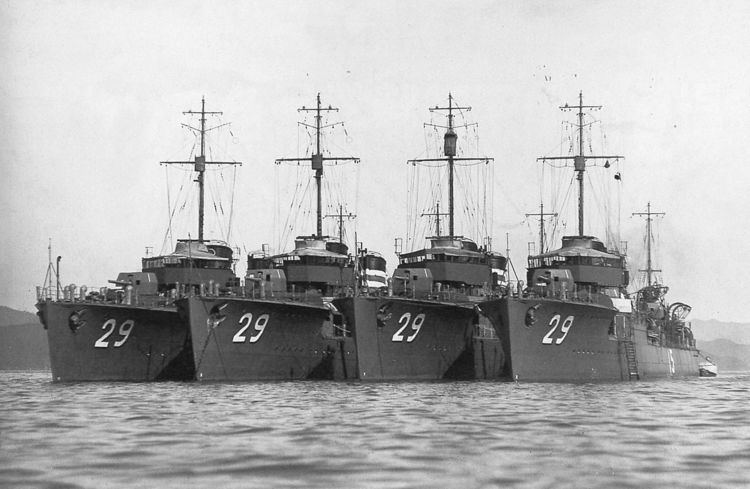Preceded by Wakatake class In commission 1921–1947 | Succeeded by Mutsuki class | |
 | ||
Builders Maizuru Naval ArsenalMitsubishi-NagasakiUraga Dock CompanyIshikawajima ShipyardsFujinagata ShipyardsSasebo Naval Arsenal | ||
The Kamikaze-class destroyers (神風型駆逐艦, Kamikazegata kuchikukan) were a class of nine destroyers of the Imperial Japanese Navy. Some authors consider the Nokaze, Kamikaze and Mutsuki classes to be extensions of the Minekaze-class destroyers, and the Kamikaze class is sometimes referred to as the "Kiyokaze class" to distinguish it from the earlier World War I-era destroyer class of the same name. Obsolete by the beginning of the Pacific War, the Kamikazes were relegated to mostly secondary roles. Most ultimately were lost to U.S. submarines.
Contents
Background
The Kamikaze-class vessels were an extension and improvement to the ongoing Minekaze-class program as part of the Eight-eight fleet Plan. They were ordered under the 1921-1922 fiscal budget. As with the Wakatake class, they were originally numbered, but were assigned individual names after 1928.
Construction of the last two planned Kamikaze vessels was cancelled in conformance with the Washington Naval Treaty. Oite, Hayate, Asanagi and Yūnagi were called the Kamikaze-class late production model (or occasionally Oite class), as the powerplant and armaments were different.
Design
The Kamikaze-class ships were visually identical to the earlier Minekaze class, apart from slight detail changes in the bridge and the addition of an improved 120 mm/50 cal. main gun which was designed as a dual purpose mount.
The Kamikaze class was the first destroyer class in the Japanese Navy to be built with a bridge strengthened by steel plating. This gave the vessels a higher center of gravity, and to counteract this they were built with an increased displacement and a wider beam for better stability. Although they had slightly less speed >37.5 knots (69.5 km/h) they were considered satisfactory compared with the Minekaze class.
Operational history
The Kamikaze-class vessels all saw combat during the Pacific War, with Hayate having the distinction of being the first Japanese destroyer to be lost in combat during that conflict. She was sunk during the Battle of Wake Island in December 1941. By 1944 four Kamikaze-class vessels had been sunk by American submarines and a fifth was lost in an air raid on Truk. In 1945 a sixth ship was sunk by submarine action. Only Kamikaze and Harukaze survived the war, but Harukaze was in such poor condition when surrendered at Sasebo that she was soon scrapped. Kamikaze continued on as a repatriation ship after it was surrendered at Singapore, but grounded off Cape Omaezaki in June 1946 and was written off.
Naming history
The IJN originally planned that the Kamikaze-class ships should have names, but upon completion they were given numbers due to the projected large number of warships the IJN expected to build through the Eight-eight fleet plan. This proved to be extremely unpopular with the crews and was a constant source of confusion in communications. In August 1928, names were assigned, but not the original names that were planned.
